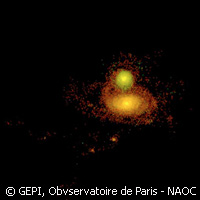Galactic blow shaped Earth's celestial neighbourhood 6 billion years ago
A Franco-Sino team of researchers has discovered that the Andromeda Galaxy and the dwarf galaxies known as the Magellanic Clouds, may owe their current shape to a collision in the 'Local Group', as experts call our celestial neighbourhood, some 6 billion years ago. The Local Group comprises almost 40 galaxies and is dominated by 2 massive spiral galaxies: Andromeda (aka Messier 31, or M31) and Earth's own galaxy, the Milky Way. The results of the first part of the study are presented in the Astrophysical Journal, and the findings of the second part of the study will be published in the same journal in December. Astronomers used to think that Andromeda, a spiral galaxy some 2.5 million light-years away in the constellation Andromeda, was created when two galaxies of smaller mass merged. But researchers from the Paris Observatory and the Centre national de la recherche scientifique (CNRS) in France, in collaboration with the National Astronomical Observatories of the Chinese Academy of Sciences (NAOC), thought of another angle and modelled for the first time the detailed structural evolution of the Andromeda Galaxy. Led by François Hammer from the Paris Observatory, the team successfully reproduced many of the galaxy's properties including its huge central bulge, the giant ring of gas and dust, the massive thick disk, and the huge stream of old stars. The researchers suggest that Andromeda resulted from the mash-up of two galaxies, one slightly bigger than the Milky Way, and the other about three times less massive. Evaluating the stellar ages of the Andromeda structures helped them determine that the first passage occurred some 9 billion years ago, and the final fusion took place around 5.5 billion years ago. According to the experts, the Local Group can probably count on this massive collision as being its most significant event in its history. Why? Because the Andromeda Galaxy and its satellites gather the biggest fraction of the baryonic matter of the Local Group, which includes stars and gas. The experts point out that the collision must have been violent in order to produce enough rotation (angular momentum) to create the massive galactic disk of Andromeda. They add that the simulations give a good idea of how an amount of mass equivalent to a third of that of the Milky Way was probably expelled during the interaction, 'through the formation of gigantic tidal tails'. Gas probably dominates most of this matter, much of which was ejected in a privileged direction such as in a hyperplane oriented along the disk of the Andromeda Galaxy. 'Because the Andromeda disk is seen almost edge-on (inclination of 77 degrees), this hyperplane may easily include the Milky Way,' the researchers say. In the second part of the study, the team looked at how such a major event could affect the immediate neighbourhood of our galaxy. No one really knows how the Magellanic Clouds were created. The researchers suggest they formed within one of the tidal tails generated during the huge interaction 9 billion years ago. 'They would have been ejected towards the Milky Way, at a very large velocity that has been recently re-evaluated to be 1 million kilometres per hour (277.777778 km/second)!' they say. The results of this study could play a crucial role in cosmology, according to the researchers. Mainly because they would support the theory that mergers created most spiral galaxies and that tidal tails during such events generate dwarf galaxies. Researchers from the Université Paris Diderot and Université Pierre et Marie Curie in France contributed to this study.
Countries
China, France



